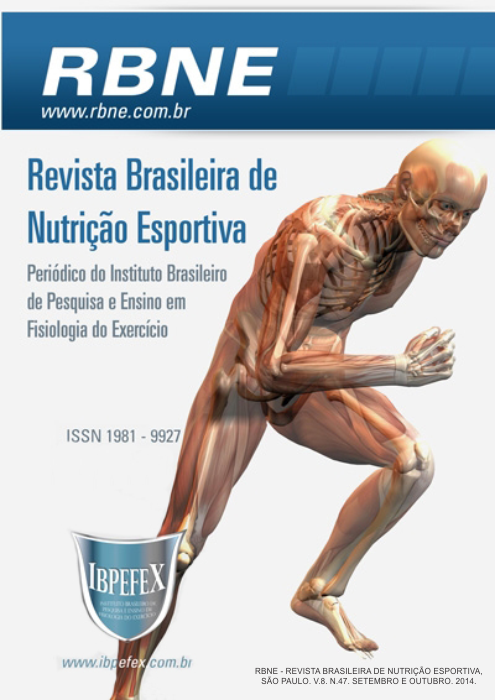Evaluation of conformity of food supplements front the current law
Abstract
The protein intake, when combined with physical activity causes an increase in performance, weight gain, hypertrophy and prevention of muscle fatigue, the whey protein, a product composed of concentrated whey is the source most commonly used by physical activities practitioners. Carbohydrates are the main source of energy in most diets of most people in the world and are important for muscle contraction during exercise. The aim of this study was to evaluate the compliance of protein and carbohydrates on labels of dietary of protein and carbohydrates on labels of food supplements. The analyses were performed in triplicate, the protein content were performed according the methodology of Kjedahl and carbohydrates by Lane-Eynon. The variation of the amounts listed on the label with experimentally obtained was 24.6, 7.1, 8.7 and 9.3% for proteins to samples I, II, III and IV, and 8.7; 16.0 and 5.1% for carbohydrates to samples II, III and IV, having not been detected in sample I. The analysis of carbohydrates of the sample I resulted in agreement with the null value of such property on the label, as compared to the protein, found itself in disagreement with the current legislation. All other analyzes resulted in higher levels of carbohydrates and lower the labeled proteins, however in accordance with the law. The current limit of tolerance advocated by ANVISA (20% variation) could be narrowed, since variationswere found up to four times smaller than this limit.
References
-Amorim, A.G.; Tirapegui, J. Aspectos atuais da relação entre exercício físico, estresse oxidativo e magnésio. Revista de Nutrição. Vol. 5. Num. 21. p. 563-575. 2008.
-Bezerra, C.C.; Macêdo, E.M.C. Consumo de suplementos a base de proteína e o conhecimento sobre alimentos protéicos por praticantes de musculação. Revista Brasileira Nutrição Esportiva. São Paulo. Vol. 7. Núm. 40. p. 224-232. 2013.
-Bobbio, P.A.; Bobbio, F.O. Química do processamento de alimentos. 2ª edição. São Paulo. Varela. 1992.
-Bobbio, F.O.; Bobbio, P.A. Introdução a química de alimentos. 3ª edição. São Paulo. Varela. 2003.
-Cyrino, E.S.; Zucas, S.M. Influência da ingestão de carboidratos sobre o desempenho físico. Revista da Educação Física/UEM. Vol. 10. Núm. 1 p. 73-79. 1999.
-Instituto Adolfo Lutz, Métodos físico-químicos para analise de alimentos. São Paulo. Instituto Adolfo Lutz. 2008.
-Jesus, E.V.; Silva, M.D. Suplemento alimentar como recurso ergogênico por praticantes de musculação em academias. In: Anais do III Encontro de Educação Física e áreas afins –Departamento de Educação Física. UFPI. 2008.
-Melo, F.F.; Bordonal, V.C.; Relação do uso da whey protein isolada e como coadjuvante na atividade física. Revista Brasileira Nutrição Esportiva. São Paulo. Vol. 3. Núm. 17. p. 478-487. 2009.
-Ministério da Saúde. Agência Nacional da Vigilância Sanitária. Resolução da diretoria colegiada –RDC nº. 18, de 27 de abril de 2010. Regulamento Técnico sobre Alimentos para Atletas.
-Naves, M.M.V.; Ferreira, C.C.C.; Freitas, C.S.; Silva, M.S. Avaliação da qualidade protéica de dois suplementos alimentares em ratos wistar. Alim. Nutr. Vol. 17. Núm. 1. p. 35-42. 2006.
-Pereda, J.A.O.; Rodriguez, M.I.C.; Álvarez, L.F.; Sanz, M.L.G.; Minguillón, G.D.G.F.; Perales, L.H.; Cortecero, M.D.S. Tecnologia de Alimentos -Componentes dos Alimentos e Processos. Porto Alegre.Artmed.2005.
-Pereira, R.F; Lajolo, F.M.; Hirschbruch, M.D.; Consumo de suplementos por alunos de academia de ginástica em São Paulo. Rev. Nutr. Vol. 16. Núm. 3. p. 265-272. 2003.
-Santos, M.A.A.; Santos, R.P. Uso de suplementos alimentares como forma de melhorar a performance nos programas de atividade física em academias de ginástica. Rev. paul. Educ. Fís. São Paulo. Vol. 16. Núm. 2. p. 174-185.
-Sgarbieri, V.C. Propriedades fisiológicas-funcionais das proteínas do soro do leite. Rev. Nutr. Vol. 17. Núm. 4. p. 397-204. 2004.
-Tirapegui, J.; Mendes, R.R. Introdução à nutrição e à atividade física. Metabolismo e suplementação na atividade física. São Paulo. Atheneu. 2005.
-Toba, Y.; Takada, Y.; Matsuoka, Y.; Morita, Y.; Motouri, M.; Hirai, T.; Suguri, T.; Aoe, S.; Kawakami, H.; Kumegawa, M.; Takeuchi, A.; Itabashi, A. Milk basic protein promotes bone and formation and suppress bone resorption in healthy adult men. Bioscience, biotechnology and biochemistry. Vol. 65. Num. 6. 2001. p. 1353-1357.
Authors who publish in this journal agree to the following terms:
- Authors retain the copyright and grant the journal the right of first publication, with work simultaneously licensed under the Creative Commons Attribution License BY-NC which allows the sharing of the work with acknowledgment of the authorship of the work and initial publication in this journal.
- Authors are authorized to enter into additional contracts separately for non-exclusive distribution of the version of the work published in this journal (eg, publishing in institutional repository or book chapter), with acknowledgment of authorship and initial publication in this journal.
- Authors are allowed and encouraged to post and distribute their work online (eg, in institutional repositories or on their personal page) at any point before or during the editorial process, as this can bring about productive change as well as increase impact and impact. citation of published work (See The Effect of Free Access).






